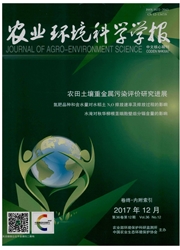

 中文摘要:
中文摘要:
为研究土壤重金属污染对作物生长尤其是根系生长的影响,探讨了利用遥感与作物生长模型同化方法获取水稻根重WRT(Weight of Root)的变化,进而动态监测水稻重金属污染胁迫的可行性。以吉林省长春市两块不同污染水平的水稻种植区为研究对象,以叶面积指数LAI(Leaf Area Index)为结合点,使用灰色关联度分析选择与根重关联度最高的作物参数CVR(干物质转化为根重的效率,Efficiency of Conversion into Roots),通过粒子群优化算法PSO(Particle Swarm Optimization)优化CVR,实现作物生长模型WOFOST(World Food Studies)与CCD遥感数据的同化,并用同化后的WOFOST模型模拟WRT进行水稻重金属污染胁迫状况分析,最后对研究区水稻重金属污染胁迫进行了分级评价。结果表明,整个生长期污染严重区域水稻根重比污染较轻区的水稻根重低,二者比值范围为0.894~0.972,均值为0.922,在水稻分蘖期比值最低达到0.894。可见根重的变化是监测水稻重金属污染胁迫的有效指标,该方法能够在水稻生长的早期(分蘖期)就监测到重金属污染胁迫。
 英文摘要:
英文摘要:
Heavy metal contamination of soil would affect crop growth via influencing eco-physiological parameters of crops such as chloro-phyll, LAI(Leaf Area Index)and cell structure, especially the roots. This study explored the feasibility of monitoring heavy metal stresses in rice by using WRT(Weight of Root)changes obtained from remote sensing data and crop growth model. Usually it is difficult to get rice WRT directly through remote sensing method. However the WRT can be well simulated by assimilating remote sensing data into the WOFOST(World Food Studies)model. The LAI is one of output parameters of the WOFOST model and it can be used as a connection between the WOFOST model and remote sensing data. The assimilation process was conducted through the LAI by PSO(Particle Swarm Op-timization). In this research, two cultivation areas in Changchun, Jilin Province were selected as the experimental sites(A and B)with dif-ferent heavy metal stress levels. Grey correlation analysis was performed to select the crop parameter that is sensitive to the WRT. The re-sults showed that CVR(Efficiency of dry matter conversion to root weight)is highly correlated with the WRT with the correlation coefficient (RWRT)of 0.801 6. Hence the CVR was chosen as the parameter to be optimized in the WOFSOT model. The CVR values of the site A and B were 0.527 and 0.806 respectively. The WRT ratio of the site A to site B ranged from 0.894 to 0.972 during the whole rice growth period with an average of 0.922. The lowest WRT ratio of 0.894 occurred at the tillering stage, whereas the significant effect of heavy metal stress on LAI started at the jointing-booting stage. The experimental results showed that the heavy metal stress can be detected by the WRT at the early growth stage compared with the LAI. In conclusion, assimilating remote sensing data into the WOFOST model can directly get the root growth information, which is impossible to obtain directly from remote sensing technique only. Additionally, assimilating remote sensing data into the WOFO
 同期刊论文项目
同期刊论文项目
 同项目期刊论文
同项目期刊论文
 期刊信息
期刊信息
